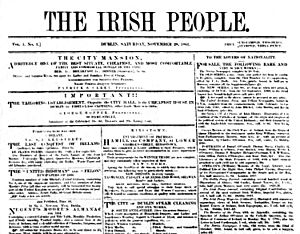The Irish People (1863 newspaper) facts for kids
 |
|
| Type | weekly newspaper |
|---|---|
| Founded | 28 November 1863 |
| Political alignment | Irish nationalism |
| Language | English |
| Headquarters | Dublin |
The Irish People was a weekly newspaper that supported Irish independence. It was first printed in Dublin in 1863. The newspaper was linked to the Fenian movement, which wanted Ireland to be free from British rule. The British Government stopped the newspaper from being published in 1865.
Contents
The Story of The Irish People Newspaper
Before The Irish People, other newspapers that supported Irish freedom had been stopped. These included the United Irishman and The Irish Felon. They were closed in 1848 because their writers were accused of causing trouble. These writers were part of a group called the Young Irelanders.
Starting the Newspaper
One of the Young Irelanders was James Stephens. He was involved in a rebellion in 1848. After the rebellion failed, he went to France. In 1856, he came back to Ireland. He then helped start a group called the Irish Republican Brotherhood (I.R.B.) in 1858.
In 1863, James Stephens decided to start a new newspaper. He got money from John O'Mahony, who founded the Fenian Brotherhood in the United States. They set up an office in Dublin.
Who Worked at The Irish People?
John O'Leary became the editor of the newspaper. Other important people working on the paper included Thomas Luby, Charles Kickham, and Denis Mulcahy. Jeremiah O'Donovan Rossa managed the business side.
The first issue of The Irish People came out on Saturday, November 28, 1863. The newspaper clearly supported Irish independence. It often criticized the way Ireland was being governed at the time.
The Newspaper is Stopped
In 1865, plans for an uprising in Ireland were discovered. Police found a letter that called for Irish people to rise up. This letter was found by a police informer named Pierce Nagle. He worked for The Irish People newspaper.
On September 15, the police raided the newspaper's offices. The very next day, the last issue of The Irish People was printed. The newspaper was officially stopped by the Lord Lieutenant, John Wodehouse.
Arrests and Trials
Many people who worked for the newspaper were arrested. These included Thomas Luby, John O'Leary, Jeremiah O'Donovan Rossa, and James O'Connor. James Stephens and Charles Kickham were arrested later. Stephens managed to escape from prison in November.
A special court case began on November 27. Many people were charged with serious crimes. The main charge was "treason felony," which means trying to overthrow the government. This charge had been used against Irish republicans before.
The evidence used against them included the letter found by Pierce Nagle. The police also used articles from The Irish People that had criticized judges. A secret document written by James Stephens was also used. This document gave some of the newspaper staff important powers within the I.R.B.
The lawyers defending the accused, like Isaac Butt, pointed out some unfair things. They noted that some of the judges involved had also been part of the arrests. They also highlighted that the juries often had mostly Protestant members, even though most people in Ireland were Catholic.
Sentences for the Staff
The people involved received different sentences:
- Thomas Luby, John O'Leary, and James O'Connor were sentenced to 20 years in prison.
- Jeremiah O'Donovan Rossa received a life sentence because he had been in trouble with the law before.
- Charles Kickham, who was almost blind and deaf, was sentenced to 12 years.

